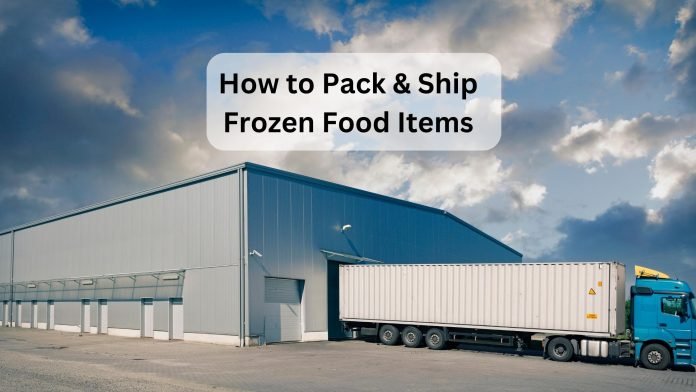Shipping frozen food is like sending a precious gift to someone. When you ship frozen food, you’re ensuring that those delicious items reach their destination while they’re still frozen and safe to eat. Whether you’re a food business owner looking to expand your reach or an individual sending a thoughtful frozen gift, this comprehensive guide will walk you through the essential steps to package frozen food for shipping.
Understanding the Importance of Proper Packaging for Foods
Before diving into the packaging process, it’s crucial to understand why proper packaging matters when shipping frozen food. Frozen food, unlike non-perishable items, requires specific conditions to maintain its quality and safety. Failure to package it correctly can result in spoilage, food contamination, and customer dissatisfaction. Here’s why packaging matters:
Temperature Control:
Frozen food must remain at or below freezing temperatures during transit to prevent thawing and bacterial growth. Proper packaging helps maintain this temperature.
Protection:
Frozen food packages need to withstand the rigors of shipping, including potential rough handling and temperature fluctuations.
Food Safety:
Packaging should meet food safety regulations and clearly communicate handling instructions to ensure that consumers handle the product correctly.
What Are the Common Challenges of Shipping Frozen Foods
Extreme Temperatures:
One of the primary challenges when shipping frozen foods is the need to maintain consistently low temperatures throughout the entire transportation process. Frozen foods must be kept at temperatures below 0°F (-18°C) to prevent thawing and spoilage.
This requires specialized refrigerated trucks and containers equipped with advanced temperature control systems.
Even a minor deviation from the recommended temperature range can result in the degradation of food quality and safety. Monitoring systems and backup cooling mechanisms are essential to mitigate the risk of temperature fluctuations during transit, especially in long-distance shipments.
Humidity:
Humidity control is another critical factor when shipping frozen foods. Excessive humidity can lead to the formation of ice crystals on the product’s surface, affecting its texture and quality. On the other hand, low humidity can cause freezer burn, which dehydrates the food and impairs its taste and texture. Packaging plays a crucial role in managing humidity levels.
Moisture-resistant packaging materials and moisture-absorbing agents can help maintain the ideal humidity conditions within the packaging. Additionally, proper insulation within shipping containers can prevent condensation and moisture buildup, ensuring the frozen products arrive in top condition.
Spoilage:
Preventing food contamination during the shipping of frozen foods is a paramount concern. Any deviation from the required temperature range or an extended transit time can result in spoilage and contamination, rendering the products unsafe for consumption.
To mitigate this risk, strict adherence to best practices in food safety and hygiene is essential.
Regular inspections of shipping equipment and cold storage facilities, as well as maintaining a well-trained and knowledgeable workforce, are crucial steps in reducing the likelihood of spoilage.
Properly sealed and insulated packaging also helps create a barrier against external contaminants and temperature fluctuations, minimizing the risk of spoilage.
How to Pack Frozen Foods for Shipping
Properly Wrap Frozen Foods:
Before placing frozen items into shipping containers, it’s essential to properly wrap them. Use airtight packaging, such as vacuum-sealed bags or plastic wrap, to seal the frozen foods. This helps prevent moisture loss and freezer burn, which can affect the quality of the products.
Make sure there are no leaks or openings in the packaging that could allow air to enter, as this may lead to thawing or the formation of ice crystals on the food’s surface.
Choose an Appropriate Insulated Box:
Selecting the right shipping container is crucial for maintaining the cold temperature of the frozen foods. Insulated shipping boxes, often made of foam or other insulating materials, are ideal for this purpose.
These boxes provide an additional layer of insulation to keep the cold in and prevent external heat from entering. Choose a box size that easily fits the frozen items to minimize empty space, which can result in temperature fluctuations.
Include Dry Ice or Gel Packs Inside the Insulated Box:
To maintain the low temperature necessary for frozen foods, include a cooling agent such as dry ice or gel packs inside the insulated box. Dry ice is a popular choice because it sublimates (changes from a solid to a gas) and maintains extremely low temperatures.
However, it requires special handling, so follow safety guidelines when using dry ice. Gel packs are another option and are easier to handle. Place the cooling agent on top of or around the frozen items to ensure even distribution of cold.
Conclusion
Proper packaging and shipping of frozen food require attention to detail, adherence to food safety guidelines, and consideration of temperature control. By following this comprehensive guide, you can confidently send or receive frozen food, ensuring it arrives in excellent condition, ready to be enjoyed.
Remember, when you’re shipping frozen food, it’s not just a package; it’s a treat for someone special. So, put that extra thought into packaging frozen food for shipping, and you’ll be sure to make their day when they open the box and find your carefully shipped frozen delights ready to enjoy. And the quality and safety of the frozen food you ship will reflect positively on your business or your thoughtful gesture as an individual.
Happy shipping!


